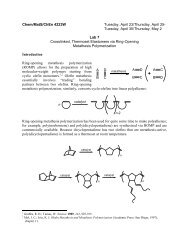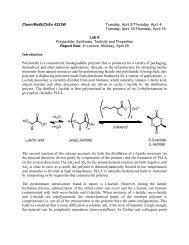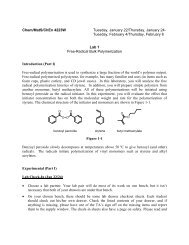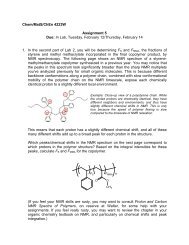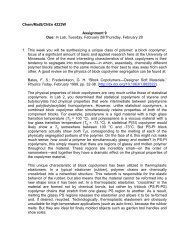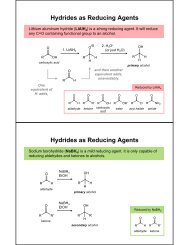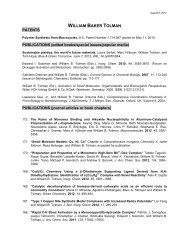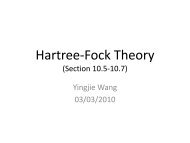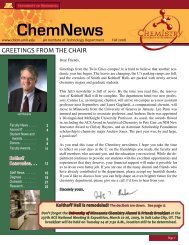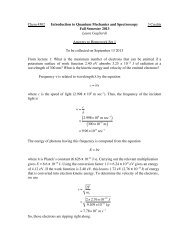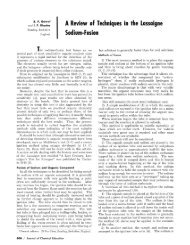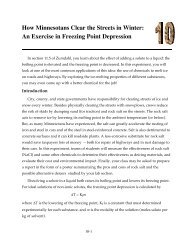Izaak Maurits Kolthoff - University of Minnesota
Izaak Maurits Kolthoff - University of Minnesota
Izaak Maurits Kolthoff - University of Minnesota
- No tags were found...
Create successful ePaper yourself
Turn your PDF publications into a flip-book with our unique Google optimized e-Paper software.
<strong>Izaak</strong> <strong>Maurits</strong> <strong>Kolth<strong>of</strong>f</strong>, February 11, 1894—March 4, 1993 | By Jo...http://www.nap.edu/html/biomems/ikolth<strong>of</strong>f.htmlstudy <strong>of</strong> the formation and properties <strong>of</strong> precipitates. In 1920-21 he published a set <strong>of</strong> 9 papers onthe significance <strong>of</strong> adsorption in analytical chemistry. After a lapse <strong>of</strong> 11 years he returned to thisfield with a vengeance, then at the <strong>University</strong> <strong>of</strong> <strong>Minnesota</strong>. Fresh crystalline precipitates tend tobe highly imperfect, but above ambient temperatures "aging" occurs, whereby purification byrecrystallization takes place. This process was studied with radiotracers, thorium B for lead andbromine activated by neutrons from a radon-beryllium source. Surface areas were measured bydye adsorption. During the period 1932-48 he published 37 papers on aging <strong>of</strong> precipitates andcoprecipitation. He continued with these studies, but on a smaller scale, until 1960. Theseinvestigations were fundamental, rather than applied, and attracted much attention (e.g., by OttoHahn).4. Voltammetry. <strong>Kolth<strong>of</strong>f</strong> became interested in voltammetry in 1933 when J. Heyrovsky, theinventor <strong>of</strong> polarography (voltammetry at the dropping mercury electrode) and future Nobellaureate, visited Minneapolis. Two <strong>of</strong> <strong>Kolth<strong>of</strong>f</strong>'s top students, J. J. Lingane (Ph.D., 1938) and H.A. Laitinen (Ph.D., 1940) began working on voltammetry, Lingane on the fundamentals <strong>of</strong> thedropping mercury electrode, Laitinen on solid microelectrodes. In 1939 <strong>Kolth<strong>of</strong>f</strong> and Linganepublished a 94-page paper in Chemical Reviews. This was followed in 1941 by an influentialmonograph with Lingane as coauthor, Polarography (Interscience, New York), expanded in1952 into two volumes. <strong>Kolth<strong>of</strong>f</strong> with several <strong>of</strong> his students continued to study voltammetry,both in aqueous and nonaqueous solutions, into the 1960s.5. Emulsion polymerization. In 1942 the Office <strong>of</strong> Rubber Reserve was set up to promote theproduction <strong>of</strong> synthetic rubber as a crucial part <strong>of</strong> the war effort. <strong>Kolth<strong>of</strong>f</strong> was one <strong>of</strong> severalprominent pr<strong>of</strong>essors, including physical chemist P. Debye, organic chemists M. Karasch and C.S. Marvel, and colloid chemists W. D. Harkins and J. W. McBain, invited to work with the majorrubber companies. <strong>Kolth<strong>of</strong>f</strong> was asked to develop analytical methods so that the rates at whichreactants were consumed could be determined. A key constituent turned out to be n-dodecylmercaptan, referred to as "OEI," for "one essential ingredient." 6 <strong>Kolth<strong>of</strong>f</strong> quickly developed aneffective method for the determination <strong>of</strong> OEI based on amperometric titration at the rotatedplatinum microelectrode with silver nitrate. This method found worldwide use after the war, whenit was published (1946). In typical fashion, immediately following this important applied research,<strong>Kolth<strong>of</strong>f</strong> launched a thorough fundamental investigation into factors influencing the rates <strong>of</strong>reaction <strong>of</strong> mercaptans, as well as the kinetics and mechanism <strong>of</strong> emulsion polymerization ingeneral. These studies led to the development <strong>of</strong> novel initiating systems that worked at lowertemperatures than usual and that produced so-called "cold rubber" with superior properties. In thisfield <strong>Kolth<strong>of</strong>f</strong> published, in addition to a number <strong>of</strong> significant papers, a monograph coauthoredwith F. A. Bovey, A. I. Medalia, and E. J. Meehan, Emulsion Polymerization (Interscience, NewYork, 1955).6. Induced reactions. <strong>Kolth<strong>of</strong>f</strong> studied a number <strong>of</strong> these reactions; one example follows.Typical <strong>of</strong> numerous induced reactions is the iron(II)-hydrogen peroxide (Fenton) reaction.<strong>Kolth<strong>of</strong>f</strong> and Medalia (1949) showed that hydroxyl radicals produced in the first step can inducethe oxidation <strong>of</strong> many organic compounds.7. Compounds containing sulfhydryl and disulfide groups. Beginning in 1950 andcontinuing until 1980 <strong>Kolth<strong>of</strong>f</strong> carried out extensive studies <strong>of</strong> the reactivity <strong>of</strong> these groups innative and denatured albumin. These papers may be among the first in bioelectrochemistry, anactive field at the present time.8. Chemistry <strong>of</strong> nonaqueous solutions. <strong>Kolth<strong>of</strong>f</strong> did much to rectify the paradox that thechemistry <strong>of</strong> solutions as typically presented in textbooks and elsewhere had (and to some extentstill has) what may be called a strong aquacentric bias, even though the majority <strong>of</strong> reactions insolution were carried out in nonaqueous media and, furthermore, water was (and is) the mostatypical <strong>of</strong> solvents. His interest in the subject dated back to the early 1930s (1931, 1934), but it4 <strong>of</strong> 10 6/23/03 2:20 PM



